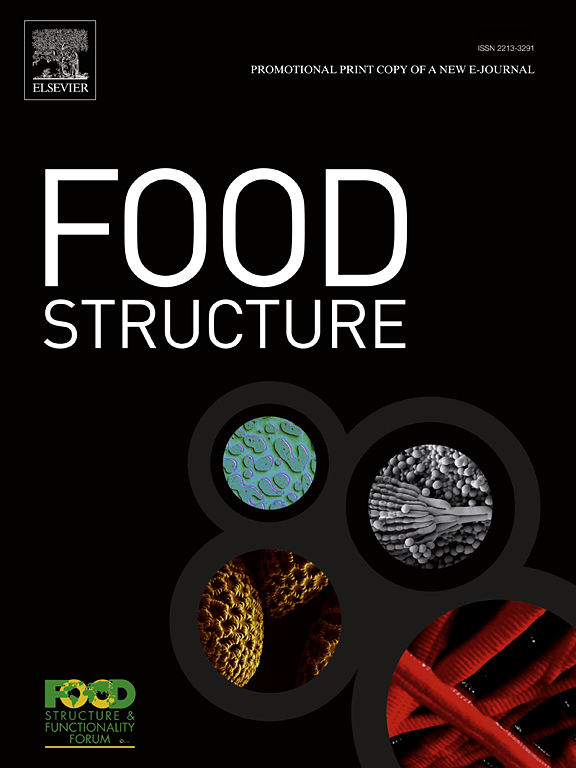Heat treatment of dark buckwheat flour improves the quality and starch digestibility of buckwheat-dried noodles through structural compactness
IF 5.9
3区 农林科学
Q1 FOOD SCIENCE & TECHNOLOGY
引用次数: 0
Abstract
Buckwheat, a nutrient-rich pseudocereal, faces challenges in noodle production due to gluten deficiency and suboptimal textural properties. This study systematically evaluated the effects of heat-moisture treatment (HMT) and dry heat treatment (DHT) on the physicochemical characteristics of dark buckwheat flour (DBF), rheological behavior of composite dough, noodle quality, and starch digestibility. The results showed that DHT-modified DBF exhibited improved solubility (25 °C, 6.75–8.80 %; 100 °C, 15.16–16.65 %), swelling power (25 °C, 3.69–4.19 g/g; 100 °C, 9.19–10.78 g/g), and enthalpy values (6.39–7.70 J/g). DHT-modified noodles showed superior mechanical properties (fracture strength and flexibility) and cooking quality (water absorption and cooking loss). Both treatments improved the hardness (3.91–12.10 %), springiness (1.03–3.94 %), and chewiness (3.68–36.31 %), tensile strength (11.45–35.73 %), and breaking length (9.91–44.62 %) of the noodles. Scanning electron microscopy (SEM) imaging confirmed that thermal treatments promoted gel matrix formation, and reduced pore size (52.03 %), pore area (79.31 %), and porosity (91.77 %), while increasing structural compactness. Both treatments reduced starch digestibility, with DHT2 achieving the lowest hydrolysis extent (C∞, 39.02 %) and rate (k1, 0.0073 min−1) of hydrolysis. This research elucidates that structural compactness is a key factor affecting food quality and starch digestibility, providing a theoretical basis for the development of low glycemic index buckwheat foods.
黑荞麦粉的热处理通过结构致密性提高了荞麦干面的质量和淀粉消化率
荞麦是一种营养丰富的假谷物,由于麸质缺乏和不理想的质地特性,在面条生产中面临挑战。本研究系统评价了热湿处理(HMT)和干热处理(DHT)对黑荞麦粉(DBF)理化特性、复合面团流变特性、面条品质和淀粉消化率的影响。结果表明,dht改性DBF的溶解度(25°C, 6.75 ~ 8.80 %;100°C, 15.16 ~ 16.65 %)、溶胀力(25°C, 3.69 ~ 4.19 g/g; 100°C, 9.19 ~ 10.78 g/g)和焓值(6.39 ~ 7.70 J/g)得到改善。dht改性面条具有优异的力学性能(断裂强度和柔韧性)和蒸煮质量(吸水率和蒸煮损失)。两种处理均提高了面条的硬度(3.91 ~ 12.10 %)、弹性(1.03 ~ 3.94 %)、嚼劲(3.68 ~ 36.31 %)、抗拉强度(11.45 ~ 35.73 %)和断裂长度(9.91 ~ 44.62 %)。扫描电镜(SEM)成像证实,热处理促进了凝胶基质的形成,减小了孔隙尺寸(52.03 %)、孔隙面积(79.31 %)和孔隙率(91.77 %),同时增加了结构致密性。两种处理均降低了淀粉消化率,其中DHT2的水解程度(C∞,39.02 %)和水解速率(k1, 0.0073 min−1)最低。本研究阐明了结构致密性是影响食品品质和淀粉消化率的关键因素,为开发低血糖指数荞麦食品提供了理论依据。
本文章由计算机程序翻译,如有差异,请以英文原文为准。
求助全文
约1分钟内获得全文
求助全文
来源期刊

Food Structure-Netherlands
Chemical Engineering-Bioengineering
CiteScore
7.20
自引率
0.00%
发文量
48
期刊介绍:
Food Structure is the premier international forum devoted to the publication of high-quality original research on food structure. The focus of this journal is on food structure in the context of its relationship with molecular composition, processing and macroscopic properties (e.g., shelf stability, sensory properties, etc.). Manuscripts that only report qualitative findings and micrographs and that lack sound hypothesis-driven, quantitative structure-function research are not accepted. Significance of the research findings for the food science community and/or industry must also be highlighted.
 求助内容:
求助内容: 应助结果提醒方式:
应助结果提醒方式:


